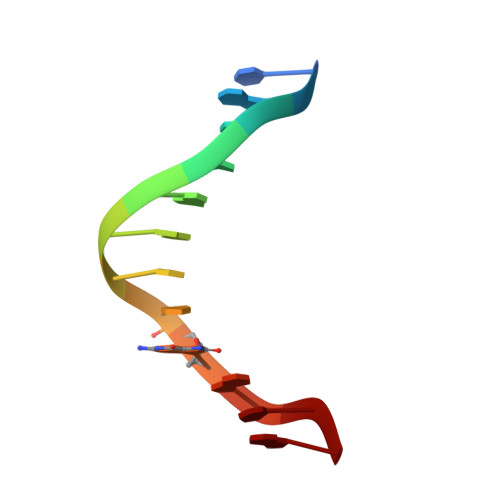Solution Structure of a DNA Duplex Containing 8-Hydroxy-2'-Deoxyguanosine Opposite Deoxyguanosine
Thiviyanathan, V., Somasunderam, A.D., Hazra, T.K., Mitra, S., Gorenstein, D.G.(2003) J Mol Biol 325: 433-442
- PubMed: 12498794
- DOI: https://doi.org/10.1016/s0022-2836(02)01272-x
- Primary Citation of Related Structures:
1N2W - PubMed Abstract:
Deoxyguanosine residues are hydroxylated by reactive oxygen species at the C-8 position to form 8-hydroxy-2'-deoxyguanosine (8-OG), one of the most important mutagenic lesions in DNA. Though the spontaneous G:C to C:G transversions are rare events, the pathways leading to this mutation are not established. An 8-OG:G mispair, if not corrected by DNA repair enzymes, could lead to G:C to C:G transversions. NMR spectroscopy and restrained molecular dynamics calculations are used to refine the solution structure of the base mismatch formed by the 8-OG:G pair on a self complementary DNA dodecamer duplex d(CGCGAATT(8-O)GGCG)(2). The results reveal that the 8-OG base is inserted into the helix and forms Hoogsteen base-pairing with the G on the opposite strand. The 8-OG:G base-pairs are seen to be stabilized by two hydrogen bonding interactions, one between the H7 of the 8-OG and the O6 of the G, and a three-center hydrogen bonding between the O8 of the 8-OG and the imino and amino protons of the G. The 8-OG:G base-pairs are very well stacked between the Watson-Crick base-paired flanking bases. Both strands of the DNA duplex adopt right-handed conformations. All of the unmodified bases, including the G at the lesion site, adopt anti glycosidic torsion angles and form Watson-Crick base-pairs. At the lesion site, the 8-OG residues adopt syn conformations. The structural studies demonstrate that 8-OG(syn):G(anti) forms a stable pair in the interior of the duplex, providing a basis for the in vivo incorporation of G opposite 8-OG. Calculated helical parameters and backbone torsional angles, and the observed 31P chemical shifts, indicate that the structure of the duplex is perturbed near lesion sites, with the local unwinding of the double helix. The melting temperature of the 8-OG:G containing duplex is only 2.6 deg. C less than the t(m) of the unmodified duplex.
Organizational Affiliation:
Sealy Center for Structural Biology, Department of Human Biological Chemistry and Genetics, University of Texas Medical Branch, 301 University Blvd, Galveston, TX 77555-1157, USA.














